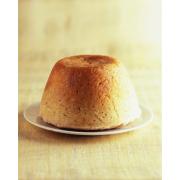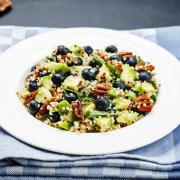Grab your apron and a whisk... it's time to set yourself the challenge of baking a traditional Sussex Pond Pudding
Words: Rebecca Pitcairn
The Sussex Pond Pudding is perhaps the county’s most famous delicacy; made by steaming a whole lemon with butter and sugar inside a suet crust, producing a marmalade-like sauce.
‘The suet crust firms up during the steaming process, while the butter and sugar melts, oozing out of the pudding when it is broken into, hence the pond reference,’ explains Haywards Heath-based food historian, writer and cook Sam Bilton. ‘The more modern 20th century version uses a lemon but the original versions of the 17th and 18th centuries would have actually been made with apples and gooseberries.’
SUBSCRIBE: To Sussex Life magazine for the very best of the county - from food and drink to art and interiors
Fans of The Great British Bake Off may recall judge Pru Leith tasking 2020’s semi-finalists to make the dense, sickly-sweet dessert, with rather disastrous results.
‘It might seem quite simple to make but it’s actually quite hard to get right and often comes out looking like a dog’s dinner,’ adds Sam. ‘The trick is time, it needs at least five to six hours to cook.’
Why not have a go at making your own Sussex Pond Pudding thanks to this easy-to-follow recipe by Regula Ysewijn?
READ MORE: 5 delicious activities for foodies in Sussex
Sussex Pond Pudding recipe
Follow this recipe to make your very own traditional dessert. Makes 2 puddings in 14cm (5½ inch/No. 42) basins (moulds)
Suet crust
- 300g (10½ oz/2 cups)
- self-raising flour
- 13g (4½ oz) shredded suet
- ½ tsp ground cinnamon
- a pinch of salt
- 2 tsp lemon juice
- 70ml (2¼ fl oz) thin (pouring) cream, chilled
- 120ml (4 fl oz) cold tap water
Filling
- 4 dessert apples, such as cox or jonagold (about 440 g/15½ oz, when cored and peeled)
- 140g (5 oz) light brown sugar
- 150g (5½ oz) good-quality butter, cubed, chilled
READ MORE: Everything you need to know about banoffee pie - from its creator
Method
1. First prepare the pudding basins by generously greasing them with butter.
2. In a large bowl, mix the flour with the suet, cinnamon and salt.
3. Then add the lemon juice, cream and cold water to bring the dough together into a stiff paste.
4. Dust the work surface with flour, roll out the dough and set one quarter of the dough aside for the lids.
5. Place the dough into the pudding basins by pressing it down. Mould it so it is roughly the same thickness all over.
6. Core, peel and large dice the apples, mix them with the sugar so all the pieces get a good coating, then add the cubes of butter so everything is divided quite evenly.
7. Divide the apple mixture between the puddings and fit a lid of dough to each pudding. Make sure you crimp the edges well, so the pudding remains closed.
8. As a variation, you can put the butter inside a cored and peeled apple and encase a whole apple in each pudding.
9. Preheat the oven to 160°C (315°F). Get a pan large enough to hold your pudding basins. Stand on a heatproof base or trivet and then pour in boiling water to come halfway up the side of the basin. Cover the pan, either with its own lid or with foil, in order to trap the steam.
10. Place in the oven and steam the puddings for 3 hours. Carefully remove the puddings from the basins and then serve.
Adapted from Pride and Pudding: The history of British puddings, savoury and sweet by Regula Ysewijn (Murdoch Books, £20).




























